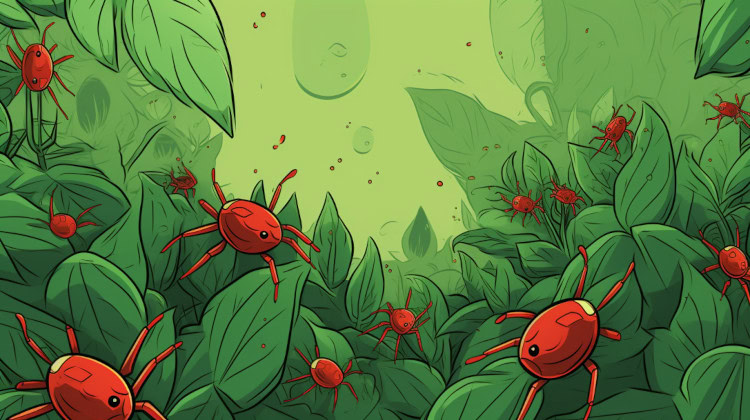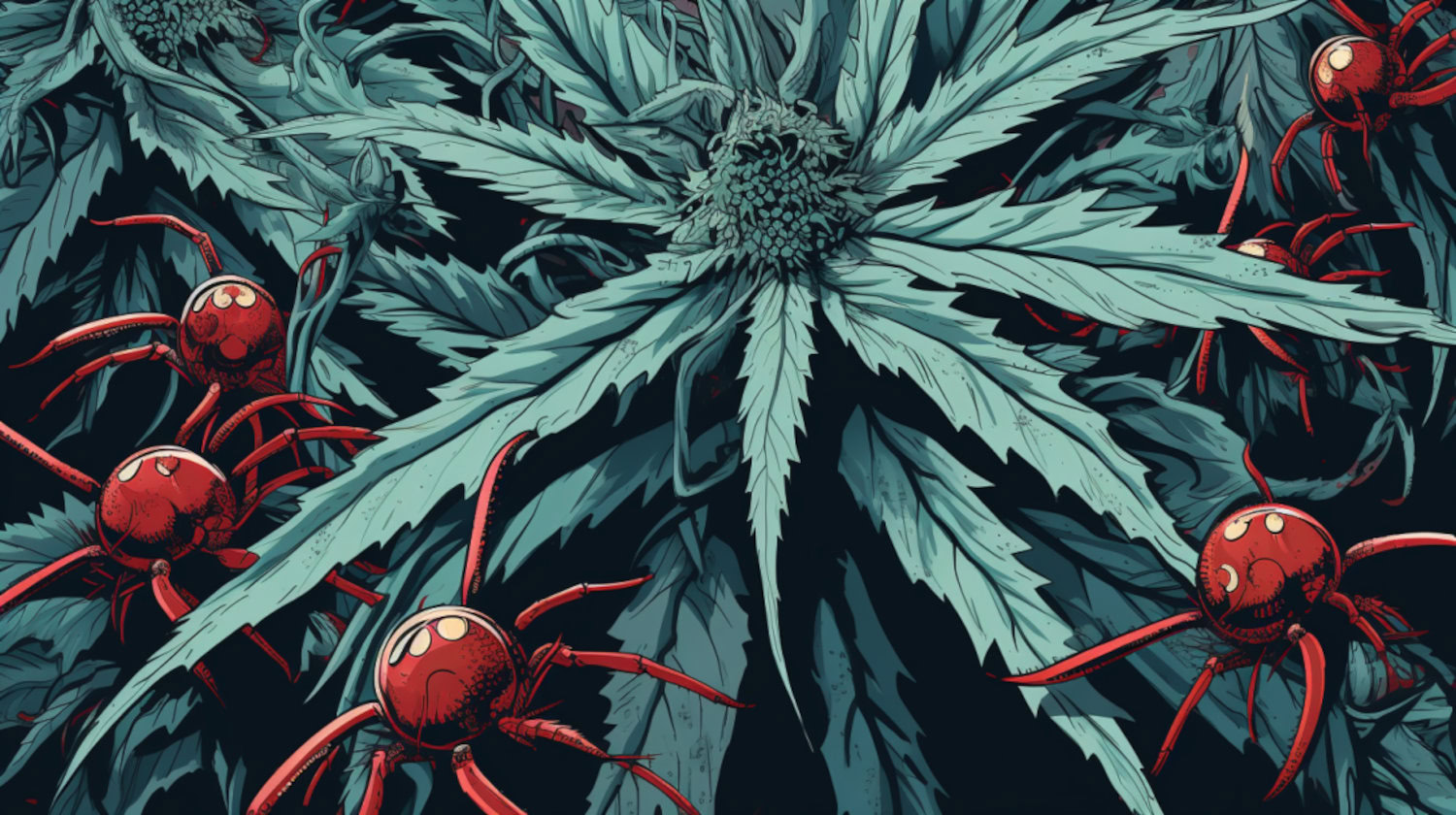Key Takeaways
- Spider mites are tiny common garden pests that affect all sorts of plants, including cannabis.
- Spider mites often leave behind small yellow or white patches on the plant.
- Natural options, like spraying your cannabis with cinnamon-clove tea or introducing predatory mites, are best for eliminating spider mites.
Legally growing cannabis can be an amazing experience. When you grow your own cannabis, you can know exactly what you’re getting and have a significant degree of control over your plants. While growing your own cannabis can be a great way to save money and be in control, there are some challenges that this situation can present.
From controlling humidity to unwanted biological aspects, there are a lot of different challenges that you should be prepared for if you’re going to be growing your own cannabis. One common problem that some cultivators face is spider mites.
If you have spider mites and are wondering how to get rid of them, then you’ve come to the right place. Let’s go over how to deal with spider mites on weed.
What are Spider Mites?
Spider mites are classified within the arachnid category. Spider mites have four pairs of legs and an oval-shaped body. Many people who garden deal with spider mites, as they’re a common issue to have.
Spider mites have unique mouthpieces that allow them to puncture plant cells and suck out the contents.
If spider mites damage your plants, there will most likely be visible evidence. Spider mites often leave behind patches or dots that are yellow or white. If your plants suddenly have these dots, then it could be a sign that you have spider mites.
Spider mites are very small and may appear like mobile dots. You’ll most likely need a magnifying glass in order to see them clearly. How many spider mites you have will likely depend on how long the infestation has been going. You may only have a few hundred mites. In some cases, infestations may mean millions of mites to deal with.
Dealing with spider mites can be challenging, as they’re sometimes difficult to get rid of. How you deal with the spider mites will most likely depend on where they are, what type of plant they’re on, and whether you want to go with a natural or manufactured solution.
Why are Spider Mites on Weed a Problem?

Protecting your cannabis plants is important, and spider mites can get in the way of that. Let’s go over some of the reasons why spider mites on weed are a problem.
One of the most obvious issues that spider mites can cause is physical damage to your cannabis. Spider mites can remove the contents from your cannabis plant’s cells, which can lead to further damage and could possibly kill your plant.
Another reason why spider mites are such a problem is because they produce a webbing that can cover your plants. This webbing often ruins cannabis plants, so taking care of spider mites as soon as possible is essential.
One of the most important things to know about spider mites is that they reproduce incredibly quickly. If spider mites are left alone, they can multiply very fast, and you could end up with millions of them. While it’s important to take care of spider mites in a prompt manner, this can also be difficult because they can sometimes be hard to spot. This is one of the reasons why it’s important to make sure that you’re regularly checking your plants.
There isn’t significant research that shows spider mites can impact cannabinoid concentrations. The main risk of spider mites is the damage that they do to the overall cannabis plant.
If you have spider mites left untreated, they could quickly spread to the rest of your crop. In just a few days, the whole crop could be ruined. Before you begin growing cannabis, consider putting some thought into how you would deal with spider mites if the issue presents itself in the future. This is a good way to be proactive and make sure that you’re on the right track.
What are the Signs of Spider Mites on Cannabis?
Spider mites on weed are a serious issue that you should watch out for. There are a few different things that you can look for if you’re worried about your cannabis plant having spider mites.
One of the most important things to look for is the damage that we mentioned earlier. Brown, white, or yellow spots on your cannabis plant are a sign that you may have spider mites.
Another sign that you may have spider mites is webbing on your plants. If webbing has suddenly appeared on your plants, then that’s a sign of serious concern. If your mite infestation has progressed to the point where webbing has occurred, then it’s likely that you’ll need to do a serious intervention as soon as possible.
If you think that you may have spider mites, consider grabbing a magnifier glass and taking a look. You should be able to see the tiny pests if they’re magnified.
What Causes Cannabis Mites?

Cannabis mites prefer environments that are hot and dry. Spider mites thrive during the warm months when their population rapidly multiplies. One interesting thing about spider mites is that they are especially attracted to drought-stressed crops.
The unfortunate thing about cultivating cannabis is that many of the conditions cannabis requires are ones that spider mites are drawn to. This is one of the reasons why it’s so important to make sure that you’re being proactive and preventing spider mites in any way that you can.
How to Get Rid of Spider Mites on Weed
If you have spider mites, know that you’re not alone. Spider mites are a common issue that cannabis cultivators face, so let’s go over spider mite treatment options.
Chemicals and conventional pesticides are an option for treating spider mites, but they’re not the best choice. Chemicals may impact your cannabis, and if you buy the wrong option, you may end up furthering your infestation.
One of the first things that you should think about is creating an environment where spider mites will not be able to thrive. This can mean changing the temperature and humidity of your area. Keep in mind that your cannabis plants may not respond well to this, so it’s something that should be done with care and after much research.
Cinnamon-clove tea can be a helpful repellent if you have spider mites. Consider researching the ways that this natural option works before you decide if it could be the right choice for you.
Another option that some people choose is predatory mites. Other types of mites can be helpful in ending a spider mite infestation, but this is an option that you should do carefully. Introducing other biological aspects into your crop can have negative results, so it’s important to make sure that you’ve examined all of the different options.
How to Get Rid of Spider Mites During Flowering

If you have spider mites on buds at the time of harvest, you’ll want to make sure that you intervene immediately. This is a critical stage, and having spider mites at this point could ruin your entire crop. Consider a treatment option that will work quickly.
How to Prevent Spider Mites on Cannabis
Are you ready to start growing your own cannabis? If you are, then you should think about what you’re going to do to prevent spider mites.
One of the most important things you can do is not introduce other plants into your space. One of the biggest ways that spider mites spread is through contact, so it’s important to thoroughly vet a new plant before you introduce it to the rest of the crop. This can be a great way to make sure that you’re not exposing your plants to potentially harmful biological agents. In addition, don’t visit a friend’s grow and then step into yours, as this can also carry bugs and pathogens to your plants.
Another thing to consider is the environment in which you’re growing your cannabis. While changing some aspects of the environment, such as the temperature and the humidity, may discourage spider mites, it may also have an impact on your cannabis. If you’re not sure what the right conditions are for your cannabis, consider doing some research and consulting with a professional.
The information in this article and any included images or charts are for educational purposes only. This information is neither a substitute for, nor does it replace, professional legal advice or medical advice, diagnosis, or treatment. If you have any concerns or questions about laws, regulations, or your health, you should always consult with an attorney, physician or other licensed professional.




